
森下明時 Mitsuyoshi Morishita|錫工芸 Casting (Tinware)|鳥取県米子市 Yonago City, Tottori Prefecture
工業高専の卒業研究で「鋳物」に関わったのがきっかけで鋳造工場に勤務以後「鋳物」の魅力に取りつかれる。
やがて趣味でも「鋳物」を作るようになり、休日はアルミ鋳造工房に弟子入り修行。30年前よりオブジェやモニュメントなど大物作品の制作依頼に応える中、錫器作りにも励んでいる。
Morishita got involved in metalwork during his graduation research project at a technical college. After his experience at a foundry, he became fascinated with casting. Eventually, casting became a serious hobby. On his days off, he dedicated himself to an aluminum casting apprenticeship. For 30 years, he has responded to numerous requests for large-scale art objects and monuments. His devotion to tinware is evident.
1953年生まれ
1983年 鋳物工場勤務のかたわらスズ鋳物による「メタルフィッシュ」を考案
1987年 鳥取県美術展覧会 工芸の部 入選
2011年 第20回総合美術展「都々良会展」 最優秀新人賞 京都市美術館展示
2012年 境港市・おさかなロードで魚オブジェの制作を始める
2014年 境港市・海とくらしの史料館で、メタルフィッシュの常設展示はじまる
2018年 COCOROSTORE特注 純錫皿の制作を始める
Born in 1953
1983: Designed the object "METAL FISH" from tin casting while working at a foundry
1987: Received the Craft Division Award at the Tottori Prefecture Art Exhibition
2011: Awarded Best New Artist at the Kyoto Municipal Museum of Art’s 20th Collaborative Art Exhibition
2012: Installation of FISH OBJECTS on Fish Road in Sakaiminato City
2014: Permanent exhibition of METAL FISH at the Sea Life Museum in Sakaiminato City
2018: Production of COCOROSTORE custom-made pure tin plates
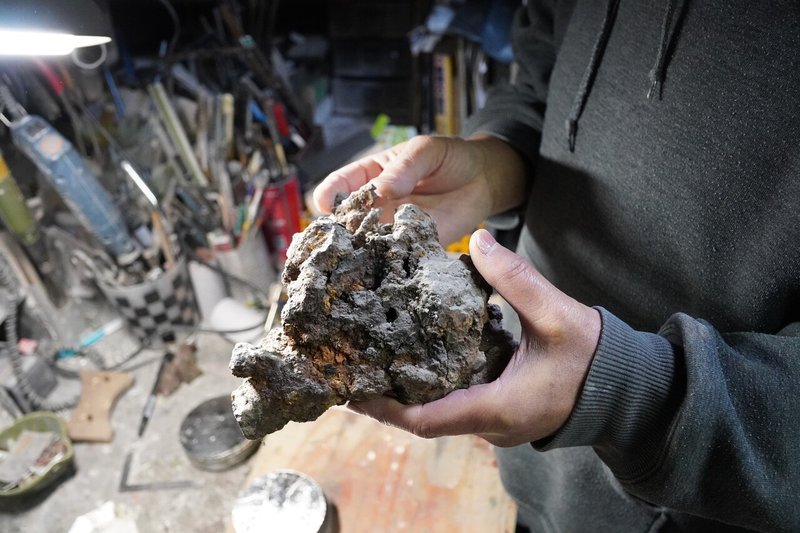
銑(ズク)/ Pig Iron
工房の棚の上に銑(ズク)が置いてあったのでこれはと聞くと20代の鋳物工場に勤め始めた頃、島根県の山中にあったタタラ場跡に伺った際、その場所を管理されていた年配の方から "君が鋳物に従事しているのなら、これをあげよう"と頂いたものだそうです。
銑とはタタラ吹きで玉鋼を製鉄する際に不純物として流れ出る鉄のことです。この銑を再利用し、鋳物師は熱し型に流し込み、また新たな形に成型したそうです。
鳥取県や島根県は良質な砂鉄が採れる産地なのでタタラ製鉄が盛んで腕の良い鋳物師も多数いたようです。
これは森下さんにとって鋳物がより好きになったきっかけで私にとって宝物だとおっしゃっていました。それから30年以上、今日まで鋳物に従事されています。
There was a strange object on a shelf in the workshop, so I asked Morishita what it was. He told me that when he started working at a foundry in his twenties, he visited the Tatara Factory ruins in the mountains of Shimane Prefecture. An elderly person in charge of the place told Morishita, “If you dedicate yourself to casting, I will give this to you.”
When making tamahagane (traditional Japanese steel made from iron sand), the impurities that flow during ‘tatara blowing' are known as 'pig iron.' Metal workers recycle pig iron by heating it and pouring it into molds. A new shape, a new life. Tottori and Shimane prefectures are sources of the high-quality iron sand used in Tatara iron manufacturing. Long ago, there was a Tatara iron boom in the area, attracting many skilled casters.
This treasured lump of pig iron made Morishita fall even more deeply in love with casting. Since that remarkable experience 30 years ago, up to today, he has fervently pursued casting.
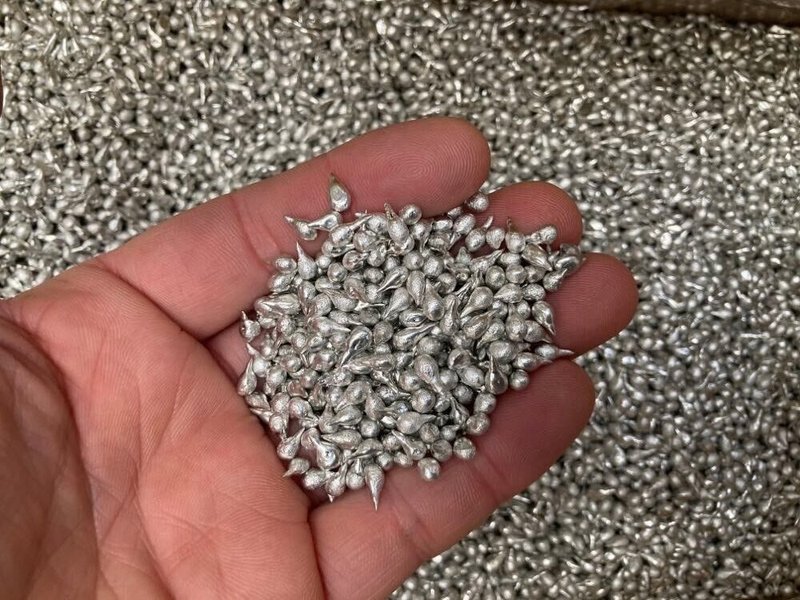
錫(すず)
純錫(錫100%)でお皿を制作していただいております。
Morishita’s hand-crafted plates are made from 100% pure tin.
錫器の歴史
奈良時代後期にお茶と一緒に持ち込まれたのが始まりとされており、錫は抗菌作用が高いという点で昔からお茶にまつわる道具に用いられ茶壷や茶筒などあります。
錫は熱伝導が高いので熱いものが冷めにくく、冷やしたものが常温に戻りにくいという点で、昔から酒器や飲み具としても重宝されています。
History of Tinware
It is believed that tin was brought to Japan around the same time as tea in the Nara period. Because of its antibacterial properties, it has long been favored in the production of teapots and tea utensils. Tin has high thermal conductivity. Hot things remain warmer longer, and cold things stay cooler longer. This makes it a sought-after material for sake vessels and containers for drinks.
錫の産出について
錫石の取れる鉱山は国内は兵庫県・大分県・鹿児島県が豊富に見つかったようです。また岩石が風化して、流水や波により堆積(たいせき)した砂錫(さすず)が多く出たのは岐阜県の一部とあります。現在では錫鉱山のほとんどが閉山し、産出はわずかとのこと。
森下さんが使用している錫は世界一の産出国インドネシア産の錫を使用しています。ここ数年で錫の物価が高騰し続けています。昨今では円安で輸入品が高騰していることや他国がインドネシア産の錫を仲介貿易されている事で高騰しているとも言われています。
About Tin Production
Cassiterite mines were found in abundance in Hyogo, Oita, and Kagoshima prefectures. In parts of Gifu prefecture, it is said that iron deposits were discovered in rocks weathered by running water and crashing waves. Most of the tin mines in Japan are currently closed. Where tin mines remain open, production is limited.
The tin Morishita uses comes from Indonesia, the world's largest producer. In recent years, the price of tin has risen sharply. The tin produced in Indonesia is traded through other countries, adding to the cost. As the value of the yen weakens, the price of foreign materials continues to skyrocket.
八角錫皿が出来上がるまでの動画
錫の特徴
錫の融点は鉱物の中でも、とても低く232℃で溶けるので火にかけると見る見るうちに液状化します。融点が低いので溶けた錫を型へ流し込むと、すぐに固形化しますので素早く型へ流し込むことが大事だと。
型へ流し込んだ器の出来上がりは気温や湿度に影響しやすいそうです。型を外してみると空気を含んでしまい皿に穴を開けてしまうことも多々あるそうです。ですが失敗した器はまた、熱を加えると溶けてくれるので再度成形が可能というのが利点です。
他の工芸素材(木・土・布・紙など)では再生が難しいものや修繕の手間がかかるのですが錫は液状化して元に戻せるという点で面白い素材だと思います。
Features of Tin
With a melting point of 232 Celsius, tin has a very low melting point compared with other minerals. When it is heated, it quickly liquefies. Since the melting point is low, when molten tin is poured into a mold, it immediately solidifies. So, it is crucial to pour it into the mold quickly.
The quality of the finished product is greatly affected by the temperature and humidity of the tin while pouring it into the mold. Air can quickly become trapped when the plate is removed from the mold, resulting in unanticipated holes. The advantage of tin casting is that if an error occurs, the tin can be melted down and reshaped. Other craft materials such as wood, clay, cloth, and paper are difficult to recycle and require much effort to repair. Tin is an intriguing material because it can be liquified and returned to its original form.
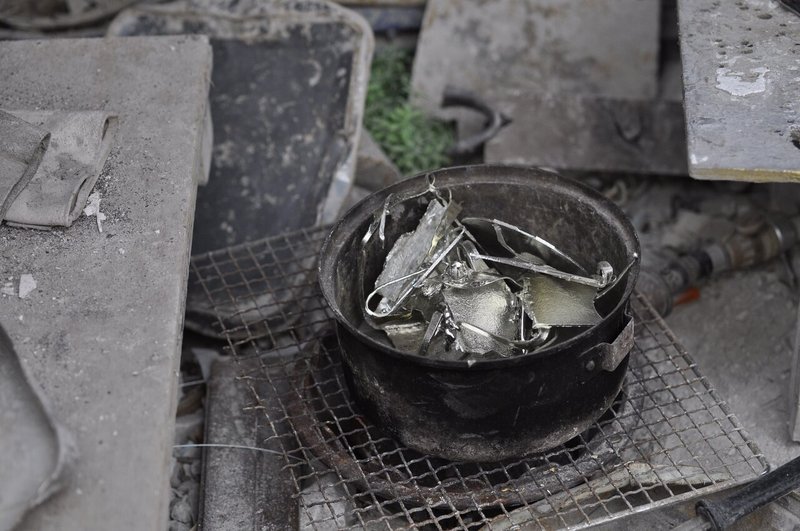
錫を流し込んだ際に型から溢れ出た錫や成形時に穴が開いた錫素材
Scraps of tin that overflowed from the mold or had air bubbles
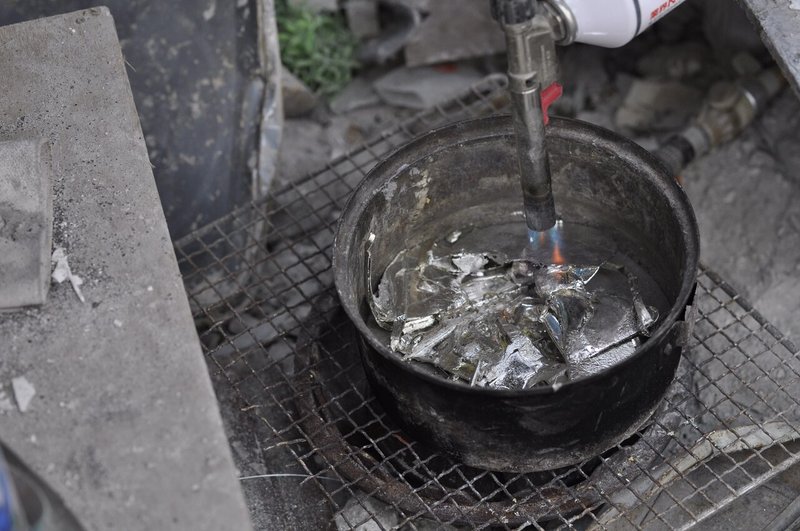
コンロとガストーチを使って溶かしていく
Melting the scraps with a torch over a stove

液状化した錫を上部から撮影
Photograph of liquefied tin from above

お皿を成形する際の型は厚紙を使用していています。この厚紙の型は2mmの厚さがあります。2mmより厚くすると器の出来上がりが重くなり、薄いと器は軽いが錫は柔らかいので力を加えると曲がりやすい(曲がりは戻せる)。 この2mm厚の型紙で仕上げた器が使い勝手が良いと試行錯誤を重ねた結果で生まれました。
A Mold made from 2mm thick paper is used to shape the plates. The finished piece will be heavy if the paper is thicker than 2mm. However, it will be light if the paper is thinner than 2mm. Light tin is soft and will bend easily when force is applied (and it can also be bent back). Morishita learned through trial and error that paper of exactly 2 mm thickness gives the best results.

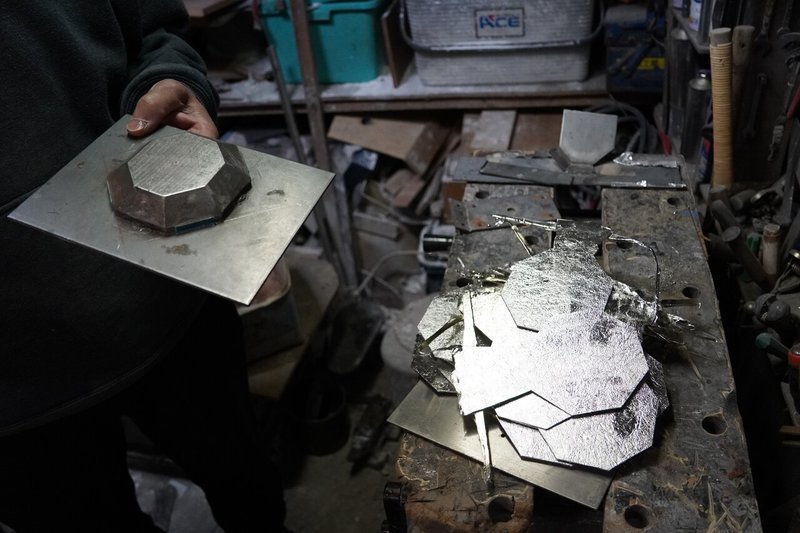
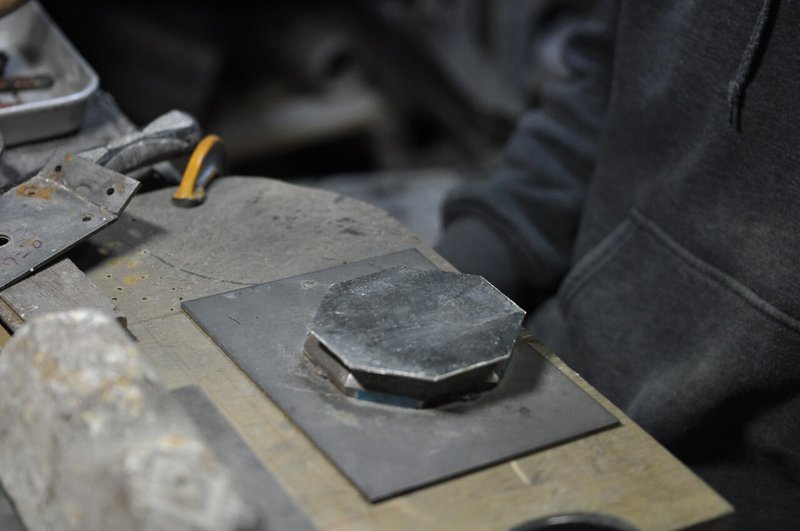
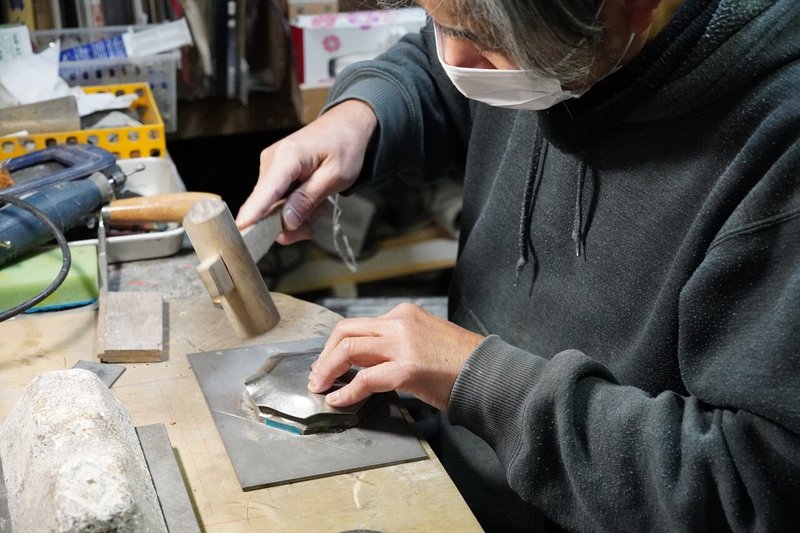
八角形の型紙に錫を流し込んだ際の余分な部分を切り落とし、八角に削り出した鉄の金型に八角形の錫板を当てて、ハンマーを使い手作業でお皿に成型します。
プレス機械を使い、金枠に押し込んで寸分狂わず作る事も出来ますが面白味にかけるので、手作業による "いびつ" が生まれ、作り手の加減が仕上がりに表現されます。その加減が器を使う人の楽しみになると感じています。
The molten tin is poured into an octagonal mold. After the excess tin is cut off, the plate is placed on a raised octagonal metal mold. Then, the plate is hammered into shape.
A mechanical press can be used to produce plates with perfect precision. Mistakes can be eliminated. However, "distortions" are what make hand-crafted objects appealing. The fine adjustments of craftsmen are where expression is born. That is where the fun and enjoyment comes for those using these plates.
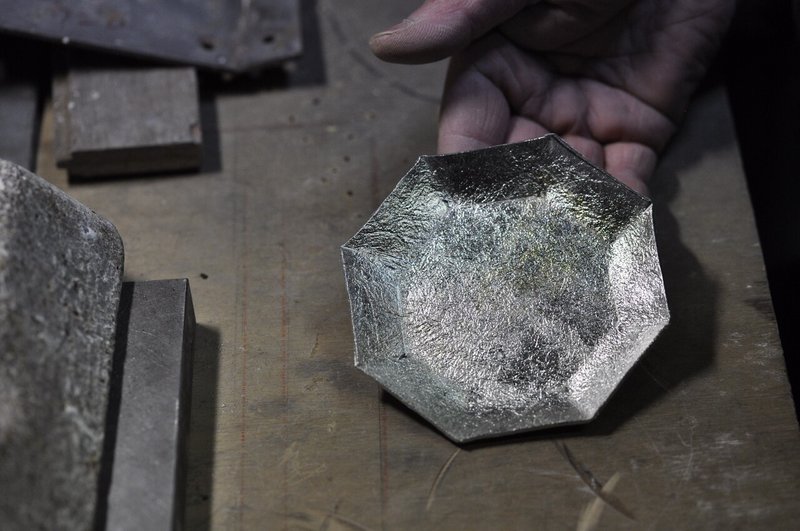
器の表面の皺(しわ)にも秘密があります。型紙を木板で挟んで錫を流すのですが、その時の木板に加工が施されています。揉んだ和紙を木板に貼り付けているので器の表面に揉み和紙の皺が表現されているのです。
最後に光沢を抑えるために酸洗い(酸性溶液)して艶消しに仕上げて完成しています。
There is a secret to the wrinkled pattern on these plates. As usual, the mold is placed between wooden boards, and tin is poured over it. But this time, the surface of the wooden boards has been given a unique treatment. Crumpled washi paper is pasted onto the boards, creating a wrinkled pattern on the tin plates. An acidic solution gives the plates a matte finish and reduces shine.

この八角皿は茶托やコースター、菓子器や銘々皿など用途を問わずお使いください。
These octagonal plates can be used for any purpose, such as a teacup coaster, serving sweets, or decorative purposes.
錫皿のご使用上の注意点
ご使用後は柔らかいスポンジを用いて、台所用洗剤(中性)で洗ってください。 純錫は柔らかいため、金タワシなど硬いものでこすらないでください、表面に傷がつきます。
融点が低いため、火気の近くに置かないでください。金属の為、電子レンジではご使用になれません。食器洗浄機や食器乾燥機はお避けください。
低温により錫が変質(変色)するおそれがあるため、冷凍庫には入れないでください。また、冷蔵庫での長時間の保管もお控えください。酸味の強いものや色の濃いものを長時間乗せたままにしないでください変色の原因となります。表面が酸化し黄色くなった場合、酸性洗剤を使い磨き洗いすると落ちます。
Precautions When Using Tin Tableware
After use, use a soft sponge and wash with gentle kitchen detergent. Pure tin is soft, so do not rub it with hard objects, such as metal scrubbing brushes, as this will scratch the surface. Due to its low melting point, do not place it near fire. Tin is not suitable for microwave or dishwasher use. Tin may deteriorate and change color due to low temperatures in a freezer. Please refrain from storing tin in the refrigerator for a long time. Do not leave acidic or dark-colored items on the surface for long, as this may cause discoloration. If the surface becomes yellow due to oxidation, it can be removed by polishing it with an acidic detergent.
森下さんはメタルフィッシュという名で活動されている一面も持ち合わせております。本物の魚から石膏型をおこして錫合金を流し込み、成形後、着色を施して仕上げています。
下のカワハギはメタルフィッシュとして活動を始めた頃の純錫の作品です。
Morishita also works under the artist name METAL FISH. He uses real fish to make the plaster molds. He pours tin into the mold, waits for it to take shape, and then hand paints the finishing touches.
The filefish below was made with pure tin around the time Morishita started working under the name METAL FISH.

2021年の年末から制作に取り掛かったマグロ(ヨコワ)の鋳物(体長85cm 重量50kg)が工房に鎮座しておりました。鳥取県境港市にある、おさかなロードに設置予定との事。
There is a casting of a 50 kg, 85 cm long tuna fish in Morishita's workshop that he has been working on since 2021. The plan is to install it on Fish Road in Sakaiminato City, Tottori Prefecture.

型おこしに使用した本物のマグロは食すことは出来ないので畑の隅に埋葬されておりました。破壊力のある南無阿弥陀仏も錫製で作成されたとの事。
幼少期から魚好きの森下さん、お魚への愛情がひしひしと伝わりました。
The tuna fish used to make the plaster mold could not be eaten. So, Morishita made a grave for it in the corner of his fields. The Namu Amida Buddha, who has destructive power, is also made of tin.
Since childhood, Morishita has been a lover of fish. In his artwork, that love is clearly felt.

|お問い合わせ先|
COCOROSTORE
〒682-0821 鳥取県倉吉市魚町2516
0858-22-3526
HP:https://cocorostore.jp
この記事が気に入ったらサポートをしてみませんか?
